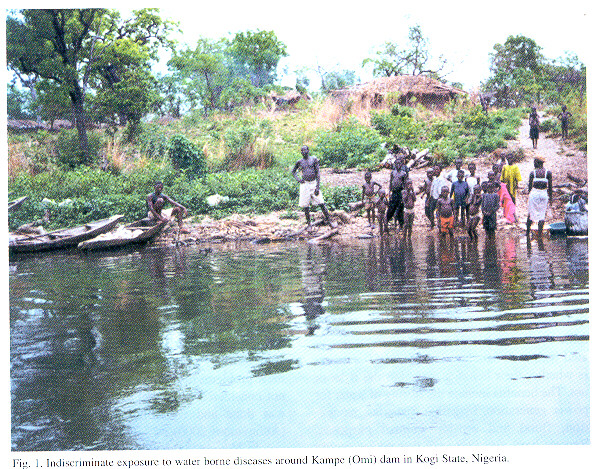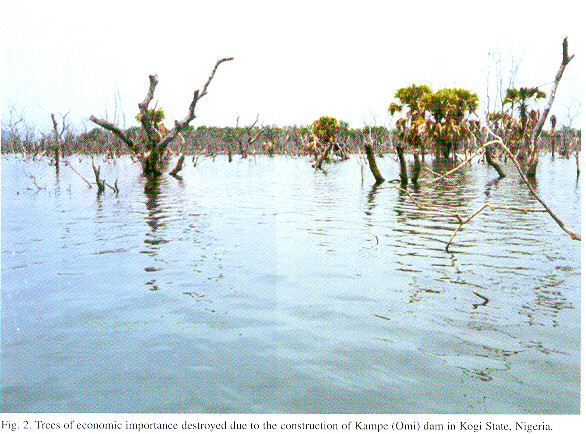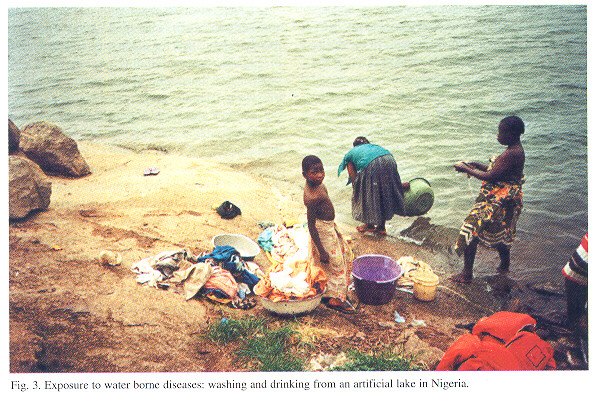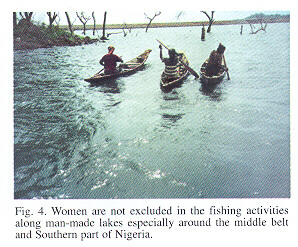Services on Demand
Journal
Article
Indicators
-
 Cited by SciELO
Cited by SciELO -
 Access statistics
Access statistics
Related links
-
 Similars in
SciELO
Similars in
SciELO  uBio
uBio
Share
Revista de Biología Tropical
On-line version ISSN 0034-7744Print version ISSN 0034-7744
Rev. biol. trop vol.50 n.3-4 San José Dec. 2002
Abstract
The benefit derived from the creation of man-made lakes in Nigeria and other developing countries is usually associated with great risks. Whenever we establish a dam, it appears we dam the inherent consequences to the detriment of man and bis environment. Debts were incurred by the countries concerned, man and animals were displaced, arable lands destroyed including degradation of forest and wild life resources. The creation of dams have also ignored the prevention of man and bis life stock from the inherent spread of water borne diseases. The purpose for which a dam is created is threatened if man is indiscriminately exposed to the risk of water borne diseases. The poor and uneconomic management of the fish resources is also another major issue of concern. In order to tap the full potentials of reservoir projects and to promote conservation, it is important to have a round table talk involving all stake holders during the planning stage of such projects. Therefore apart from the engineering works, there is also need for collaboration with all experts from relates fields especially the biologists, sociologists and economists for bio-socio-economic reasons during the planning and implementation stages of dam projects in Nigeria and other developing countries.
Key words
Artificial lakes, dams, conservation, fish resources, Nigeria.
The quality and the quantity of food available constitute a very important factor among others in the balance of a population within a complex community as diat of the aquatic and terrestrial enviromnents. The creation of embankments such as dams, dikes, etc., may disrupt this balance by interfering with the quality and the quantity of the available food items, living space, inter and intra specific competition and the limnological conditions (Araoye and Jeje 1999 ).
Recent reports have shown that the gains from the River Basin Development Project are quite enormous, however there are risks associated with such benefits. The point of the matter is whether their benefits outweigh the risks or not. The benefits include the storing of water for power generation, irrigation, fisheries, navigation, flood and erosion control purposes. Reports have also indicated that power supply from large dams account for about a quarter of the world's total supply of electricity (Dellere 1989 ). However, most of these benefits highfighted are not usually devoid of financiar and enviromnental problems. As we try lo maximize the benefits of dam projects, we should also try to minimize its negative effects through a better planning and management. Debts have been incurred heavily by some third world countries that have engaged in large water projects, people have heen displaced, arable lands were destroyed, forest and wild life resources degenerated. The spread of water borne diseases and the collapse of coastal fisheries are also harmful consequences of such big projects. Some of these problems though were foreseen, they were not considered as crucial until when the harm was done and could no longer be ignored ( Anonymous 2000 ).




What interests me in the study of the ecology of Synodontis schall in Asa dam, llorin, Nigeria, for my Ph.D. at the University of Ibadan, was its distribution and abundance within its environment. The scramble for this fish at a popular fish market in Borin, shows that it is highly relished by the coinmunity. This is because of its small to medium size range that has made its price abordable especially to the low income group. Both fresh and dried fish are usually available at the local fish markets almost through out the year, and most abundant during the dry season. I get interested in studying its environment in relation with its feeding habits, distribution and abundance, reproductive biology, age and growth studies and gill net efficiency. I noticed that this fish was diverse in its feeding habits because it feeds on a variety of food items including insects, mollusk, detritus, plant materials and fish scales ( Araoye and Jeje 1999 ). These food items were dispersad all along the surface, shore and bottom habitats which constitute the three major ecological niches of their environment (Araoye 1999 ). Even though this fish was classified as omnivore in the environment of Asa dam (Araoye and Jeje 1999 ), reports from River Benue showed that S. schall was grouped among the predatory species because their choice of food ranged from an assortment of invertebrates to other fishes (Fagade 1983 ). The distribution of the wide variety of food items along the surface, shore and bottom avails the fish the opportunity to explore the different habitats at different seasons of the year (Araoye 1999 ). The presence of a physostomous swim bladder, the bony shield of the head and high fat deposition provided the fish the opportunity to explore the bottom habitat despite higher pressure (Willoughby 1976 ). The production potential of this fish has been hampered due to un-controlled fishing around the dam and the lukewarm attitude towards the management of the lake fisheries. In my study of the gill net efficiency, it was noticed that fish specimen below the age group one were captured by the fishermen. Hence it was suggested that the use of net meshes below 7.62 cm around the lake should be discouraged (Araoye 1998 ). Synodontis are unique in the sense that they are specially armored due to the presence of well developed cephalo-nuchal shield attached with sharp dorsal and pectoral spines. lt was funny to Professor Adewolu, one of my colleagues, when she saw me in my laboratory with a mini saw blade that was being used initially to cut this bony shield of the head from the dorsal surface to expose the brain in search of the pair of the otoliths. lt was also interesting to detect a defect in the size of a pectoral spine in one of the specimens out of the 813 specimens that I worked with. This defect was a rare occurtence caused by an injury which probably became infected during healing (Araoye 2000a ).
Although this fish spawns annually and exhibited high fecundity, there is still a great threat to its sustainability if fishing and natural mortality continue to progress over the recruitment rate in this environment. The preponderance of the juveniles of this fish in the fisherrnen catches during the months of November to December was as a result of the progeny that emerged from the reproductive activities which was at its peak in July to August (Araoye 2001 ). This indicates poor and uneconomic fishing activities due to bad management of the lake fishery. The enforcement of fishery rules and regulations to protect valuable water resources in Nigeria and other West African countries is taken with levity. The factors that are responsible for this problem are many ranging from defects in the policies and the mode of implementation to defects in the expertise, attitude and practices of the fishermen and their communities particularly the consumers. Due to ignorance, there is a general belief among the local fishermen that fishery resources can never be depleted or exhausted because it is a gift from heaven. Unless we correct this erroneous perception, our fishery resources would continue to remain in a state of emergency. Hence I recommended advocacy program to sensitize the fishermen and the community on conservation needs in order to sustain this fish species as others as well (Araoye 2000c ). This program would involve the training of peer educators on conservation, and also information dissemination on conservation needs through dramas, role plays and use of IEC (Information, Education & Communication) materials such as posters, hand bills, etc. Although I have started on this program along Kampe (Omi) dam, however funding is another major obstacle facing fishery experts in Tropical West Africa. Assistance from internacional agencies, private agencies and non-govemmental organizations (NGOs) may bring succor to this major obstacle.
I worked with six fishermen leaders for fishing and record keeping during my study in Asa dam, because I wanted the information from my research findings to get to the grass roots. Most of the researches that have been carried out in the past on fish biology did not carty the grass roots along hence their findings may not be impacted because such findings only circulate within the academic environment. I was a full time post graduate student because I took a study leave. I was able to sustain the study financially through my little savings and through the little stipend of N3600 per annum (approximately $28 per annum) being paid to me as award for post graduate teaching assistant only between the year 1991-1993. I was able to win this award through the assistance of my supervisor, C.Y Jeje of the Department of Zoology University of Ibadan, Nigeria. Further help was received from J.S. Omotosho of the Department of Biological Sciences, University of llorin, who assisted in the identification of the fish species, while S.S. Ogbogu of the Department of Zoology, Obafemi Awolowo University, lfe, Nigeria, helped in the identification of the various insects. The libraries of the University of Ibadan and University of llorin were most useful for literature review, while N.G. Willoughby of Natural Resources Institute (N.R.I.), United Kingdom sent me relevant pubIications of his work on the genus Synodontis. The Chief Laboratory Technologist of the Department of Zoology University of Ibadan, O.A. Ibrahim also supported me in water sample analysis while the meteorological unit of the llorin International Airport supplied meteorological data. For now, I have decided to remain in fisheries development and ecological programs because I want to practice my academic knowledge for the benefit of the people in order to sustain the aquatic resources particularly fisheries. I still hope to end my academic career in the University here or abroad. Since I completed my PhD program in 1997, I have met and worked with over 500 local fishermen and my experience with them has heen very exiting. Although I experienced communication problem with some of them, who don't speak my local language or English due to illiteracy, however I am able to overcome this problem because a few among them attended elementary schools and can interpret my messages to their colleagues in their local language. In the past these fishermen and poachers usually run away from govemment officials but this orientation has started changing due to enlightenment programs and they are now getting closer and becoming more friendly not only to the government officials but also to the environment in which they operate.
Apart from the primary objective of creating these water bodies, there is usually no interest for the tapping of some other benefits that could be derived from such projects to alleviate poverty. Hence the full potentials of such water bodies remained untapped and wasted. Big dam projects are supposed to be of multipurpose use, therefore it is not only the engineers who may be interested in the construction works alone, but there is also the need to involve experts from other related discipline for bio-socio-economic reasons. Hence biologists, sociologists and economists are to join hands together with the engineers during the planning and the implementation stages of man-made lake projects in Nigeria and other tropical regions.
Acknowledgement
I am grateful to Afremedev Consultancy Services Limited for giving me the opportunity to share my experiences with their consultants in the ecological study of Kampe (Omi dam) and irrigation project in Nigeria. I thank F.A. Adeniji of the University of Maiduguri Nigeria and S.O. Fagade of the University of Ibadan - Nigeria. I am also grateful to Atab Nigeria Investment Limited for inviting me to contribute in the study of Environmental Impact Assessment (EIA) of Tada -Tshoga flood plain and irrigation project of the Lower Niger River Basin Development Authority, llorin - Nigeria.
I thank my employer, for providing the enabling environment to exercise my knowledge.
Resumen
La creación de represas y lagos artificiales en Nigeria y en otros países en vías de desarrollo, produce importantes beneficios, pero trae también grandes riesgos, pues es difícil evitar sus consecuencias inherentes, hacia el detrimento del hombre y su ambiente. Los países que desarrollan este tipo de proyectos deben adquirir deudas, desplazar personas y animales y enfrentar la destrucción de tierras que podrían utilizarse para cultivo, así como también la degradación del bosque y la vida silvestre. Se ha ignorado además, el riesgo que representa para el hombre y su ganado, la exposición indiscriminada a enfermedades transmitidas por el agua. El manejo pobre y antieconómico de los recursos pesqueros es otro factor importante a considerar. Con el objetivo de lograr un mejor aprovechamiento del potencial de las represas y promover la conservación, es importante organizar mesas redondas que involucren a todos los que participan durante la fase de planeamiento de los proyectos. Además de los trabajos de ingeniería, se necesita de la colaboración interdisciplinaria de expertos en áreas relacionadas, para los aspectos bio-socio-económicos de las fases de planeamiento e implementación de los proyectos de embalse, tanto en Nigeria como en otros países en vías de desarrollo.
References
Achionye-Nzeh, C.G. & O.G. Omoniyi. 2002. Lipid composition of the fishes Heterotis niloticus, Brycenus nurse, Gnathonemus cyprinoides and Sarotherodon galilaeus from a small lake in Nigeria. Rev. Biol. Trop. 50: 253-257. [ Links ]
Anonymous. 1985. WHO for drinkig water, recommendation. World Health Organisation, Macmillan, pp. 17- 48. [ Links ]
Anonymous. 2000. Environmental Impact Assessment Report. Kampe (Omi) dam and irrigation project Kogi State, Nigeria. Report submitted to the Lower Niger River Basin Development Authority, by Afremedev Consultancy Services Limited, llorin, Nigeria. 207 p. [ Links ]
Araoye, P.A. 1998. Gill net efficiency for Synodontis schall (Pisces: Mochokidae) in the environment of Asa lake, llorin Nigeria. J. Pure Appl. Sci. 13: 636-644. [ Links ]
Araoye, P.A. 1999. Spatio-temporal distribution of Synodontis schall (Teleotei: Mochokidae) in Asa dam llorin, Nigeria. Rev. Biol. Trop. 47: 1061-1066. [ Links ]
Araoye, P.A. & C.Y. Jeje. 1999. The diet of Synodontis schall (Bloch & Schneider 1801) in Asa dain Ilorin, Nigeria. Nigerian J. Nat. Sci. 33: 67-76. [ Links ]
Araoye, P.A. 2000a. Pectoral spine size in Synodontis schall (Teleotei: Mochokidac) in Asa lake llorin, Nigeria. Rev. Biol. Trop. 48: 519-510. [ Links ]
Araoye, RA. 2000b. A base line study for an intervention program to promote sustainable fisheries in the environment of Kampe (Omi) dam and Irrigation project, Kogi State, Nigeria. Biosci. Res. Comm. 12: 331-336. [ Links ]
Araoye, RA. 2000c. Conservation needs for the fisheries resources of Kampe (Omi) dam and irrigation project in Kogi State Nigeria. (accepted) In Proceedings of the 15th annual conference of the Fisheries society of Nigeria. 191 - 241 March 2000, Jos Plateau State, Nigeria.
Araoye, P.A. 2001. Morphology of the gonads in die reproductive cycle of Synodontis schall (Teleotei: Mochokidae) in Asa dam llorin, Nigeria. J. Aquatic Sci. 16: 105-110. [ Links ]
Chow, N., G. Umaña & F. Fernandez. 1994. Comparación del fitoplancton en dos bahías del Embalse de Arenal (Costa Rica) empleando el microscopio electrónico. Rev. Biol. Trop. 42: 333-338. [ Links ]
Dellere, R. 1989. Land and food. The challenges of sustainable agriculture in the Tropics. Technical Center for Agriculture and rural cooperation (CTA), Wageningen, Netherlands. 96 p [ Links ]
Duarte S. & E Gerson Araújo. 2002. Fecundity of the Hypostomus affinis (Siluriformes, Loricariidae) in the Lajes Reservoir, Rio de Janeiro, Brazil. Rev. Biol. Trop. 50: 193-197. [ Links ]
Fagade, S.O. & A.A. Adebisi 1979. On the fecundity of Chrysichthys nigrodigitatus (Lacepede) of Asejire dam, Oyo State, Nigeria. Nigerian J. Nat. Sci 1: 127131. [ Links ]
Fagade, S.O. 1983. Food and feeding habits of the fishes of Lower River Benue, Nigeria. Bull. De IFAN. Jan. I.T. 45 Ser. A. No. 3-4: 316-314. [ Links ]
Fawole, O.O. & G.A.O. Arawomo, 2000. Fecundity of Sarotherodon galelaeus (Pisces: Cichlidae) in Opa reservoir, Ile-lfe, Nigeria. Rev. Biol. Trop. 48: 201-204. [ Links ]
Fawole, O.O. 2002. Morphometry and diet of Mormyrus rume in the Lekki lagoon, Nigeria. Rev. Biol. Trop. 50: 689-694. [ Links ]
Goldman, C.R. 1976. Ecological aspects of water impoundment in tropics. Rev. Biol. Trop. 24(Suppl. 1): 87-112. [ Links ]
López-López, E. & J.A. Serna-Hernández. 1999. Variación estacional del zooplancton del embalse Ignacio Allende, Guanajuato, México y su relación con el fitoplancton y factores ambientales. Rev. Biol. Trop. 47: 643657. [ Links ]
Mora J., M, J. Cabrera P. & W. Alvarado B. 1997. Crecimiento y maduración sexual de Astyanax fasciatus (Pisces: Characidae) en el embalse Arenal, Guanacaste, Costa Rica. Rev. Biol. Trop. 45: 855- 859. [ Links ]
Saliu, J.K., Jr. 1989. Aquatic insects associated with plants in two reservoirs at Ibadan, Nigeria. Rev. Biol. Trop. 37: 217-220. [ Links ]
Saliu, J.K. 2002a. Size, sex and seasonal dynamics in the dietary cornposition of Brycinus nurse (Pisces: Characidae), from Asa reservoir, llorin, Nigeria. Rev. Biol. Trop. 50: 233-238. [ Links ]
Saliu, J.K. 2002b. The diet of Brycinus nurse (Pisces: Characidae) from Asa reservoir, llorin, Nigeria. Rev. Biol. Trop. 50: 239-242. [ Links ]
Ulloa Rojas, J., O. Alpírez Quesada & J. Cabrera Peña. 1988. Presencia de Bryconamericus scleroparius, Poeciliopsis turrubarensis y Cichlasoma nicaraguense en el Embalse Arenal, Costa Rica. Rev. Biol. Trop. 36: 171-172. [ Links ]
Umaña, G., F. Villalobos & B. Bofill. 1997. Distribución vertical de zooplancton en el Embalse Arenal, Costa Rica. Rev. Biol. Trop. 45: 923-926. [ Links ]
Umaña, G. & C. Collado. 1990. Asociación planctónica en el Embalse Arenal, Costa Rica. Rev. Biol. Trop. 38: 311-321. [ Links ]
Willoughby, N.G. 1976. The buoyancy and orientation of the upside-down cat fishes of the genus Synodontis (Pisces: Siluroidei). J. Zool. Lond. 180: 291-314. [ Links ]
* Lower Niger Basin Development Authority, P.O. Box 5565, llorin - Nigeria; Tel: 23431224090; paraoye@skannet.com and Present address: Departament of Biological Sciences. University of llorin, llorin-Nigeria.














